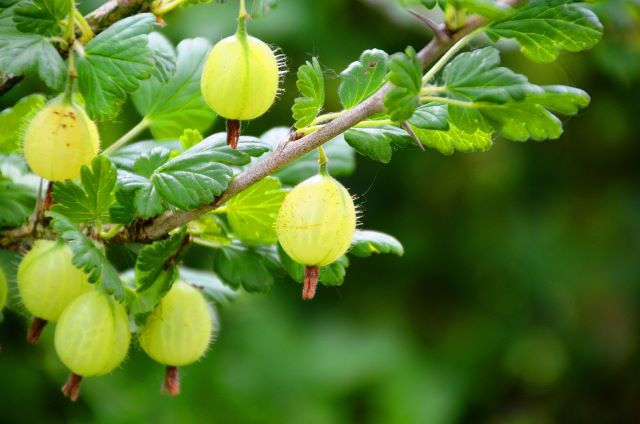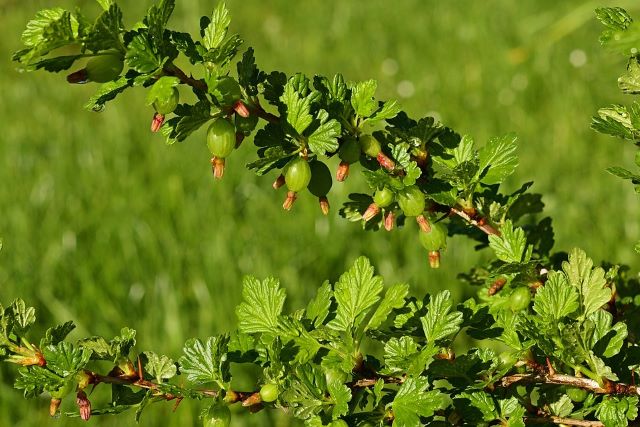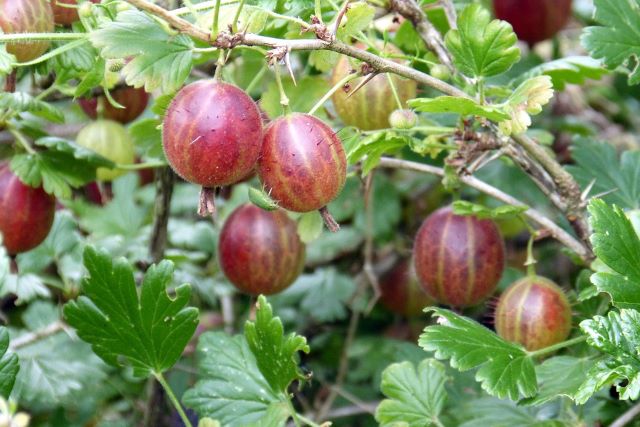Gooseberries are a fantastic addition to your garden and the deliciously tart berries make amazing jams and pies. But if your gooseberry plant is only producing small gooseberries you’re going to want to know why and how to fix it. Read on to find out.

Table of Contents
Why Are My Gooseberries So Small?
Common causes of small gooseberry fruit are growing in the wrong climate, incorrect sunlight, incorrect watering, crowded planting conditions and strong wind. Some pests, diseases and a lack of plant maintenance can also affect the size of your gooseberry fruit.
Let’s find out more about the causes of small gooseberry fruit and how you can fix the problem and help your gooseberry plant to produce large, delicious berries.
Just before we do, it’s a good to keep in mind that generally gooseberries grow to grape size or 1/2 an inch to 2 inches (1.25-5 cm) in diameter and this will depend on the varity. Ok, let’s start.
1. Wrong Climate

Growing gooseberries in the wrong climate can produce stunted gooseberry plants and small berries. In particularly hot climates where temperatures are heading regularly above 80 °F (27 °C), gooseberry plants will become stressed and may not grow or produce at all.
Gooseberry plants prefer to be grown in climates with cool summers and mild winters. Ideally, gooseberries will grow best in temperatures ranging from 45-75 °F (7-24 °C).
They are also cold hardy to temperatures down to -40 °F (-40 °C) depending on the cultivator and provided the soil has good drainage. Keep in mind that frost during flowering or fruiting can damage gooseberry fruit, so fruiting plants should be protected with a frost cover.
Growing in the US, gooseberries do well in zones 3-6.
2. Incorrect Sunlight
Gooseberries love a position in the garden in full sun of at least 6 hours to part shade. In the right cooler climate, gooseberries will thrive in full sun.
A poorly lit spot in the garden will not produce large gooseberry fruit nor will the plant produce as many berries. So avoid planting your gooseberry plants under overhanging buildings, structures, or dense trees with too much shade.
In warmer climates, the hot, midday summer sun can be too much for gooseberry plants and they may need some protection.
In this case, you can try planting gooseberries in a partly shaded, or covered area. This would be ideal for the gooseberry plant to produce bigger, juicer berries as they prefer the cool sunshine to thrive.
I have my gooseberries planted on the east side of my house which provides some shade from the midday sun during summer.
Achieving the right amount of sunlight for your gooseberry plant will ensure the best conditions for growing delicious and bigger berries.
3. Incorrect Watering
Dry conditions with no rainfall, or lack of watering, will affect the growth of gooseberries causing stunted plant growth and small gooseberries.
Another consideration is that there could be too much water which leads to soggy soil. Gooseberry plants will suffer in water-logged soil and fail to produce a healthy harvest of berries.
Once established, gooseberry shrubs do well with a drip irrigation system to provide regular water. This is definitely my preferred method of watering. I can set my timer and then I don’t have to worry about watering my plants.
Once established, gooseberries do survive and even thrive in areas with regular rainfall alone but this will depend on your climate. If you live in a climate with regular rain, then additional watering may not be required.
Though keep in mind if a heavy rainfall period is predicted you should hold off any additional watering to avoid a welling up of water around your gooseberry plant roots.
4. The Wrong Soil Conditions
Providing the right soil conditions is even more important than the position of the gooseberry plant.
Very dry soil, or very water-logged soil, and poorly fertilized soil will each hinder the growth of the gooseberry crop. This will leave you with small gooseberry fruit.
Sandy soil and clay-like soil are not good options for growing your gooseberry plants. In sandy soil, water and nutrients will drain away too quickly. While in clay soil, water won’t drain quickly enough. This can lead to gooseberry plants being waterlogged which eventually leads to plant death.
Gooseberries thrive in well-drained fertile soil with a pH of 6-6.5 (you can check your soil pH with a soil monitor here). Well-draining soil means the soil should retain some moisture without creating a water-logged scenario.
Adding aged organic matter such as compost and animal manure to your light (sandy) and heavy (clay) soil will improve drainage and soil fertility.
I compost at home so adding regular homemade compost to my soil helps my gooseberry plants produce healthy and large berries.
The use of an organic berry fertilizer like this one will also give the soil and gooseberry plant everything it needs to produce well.
I also recommend using mulch to help protect the soil and gooseberry plant roots. Mulch not only stops the soil from drying out, but it also feeds the soil as it breaks down over time.
5. Crowded Planting Conditions

Planting gooseberries too closely together can inhibit growth and cause those unwanted small gooseberry fruit. Crowded planting conditions also increase humidity around the plant which gooseberries don’t like.
Plant your gooseberry plants in an open space, 4 –5 feet (1.2-1.5 m) apart. This allows for good airflow around the plants which will also help keep humidity down.
If your gooseberry plants are in a greenhouse, using fans is effective in providing air movement.
While airflow is important, keep in mind gooseberry plants will suffer in very windy conditions. So be sure to plant your gooseberries in a protected part of the garden, away from strong winds.
6. Gooseberry Pests
Some common pests that affect gooseberry plant growth and therefore fruit yield include aphids, spider mites, a number of caterpillars and sawfly larvae.
Planting a diverse garden will help control pests by attracting beneficial insects such as lady bugs who feed on insects such as aphids. Aphids are easy to spray of the plant with water. I use horticultural neem oil for spider mites and caterpillars and sprinkle diatomaceous earth around the gooseberry plant for sawfly larvae.
For a particularly bad caterpillar infestation, you might want to use an organic pesticide but like any pesticide, I suggest only using it sparingly.
7. Gooseberry Diseases
Scab
This is a fungal disease that causes your gooseberries to shrivel and appear as if they have been boiled. This will affect their size and stunt their growth.
Cut back dead stems annually, regularly mulch, and weed around the plant to allow for three of four strong stems to remain for growth.
Anthracnose
Small black or brown spots develop on the leaves or shoots and grow to much larger spots, causing the top leaves to disintegrate and causing the shoots of the plant to be infected and die off. This will affect the strength of your plant, the production of berries as well as the quality and size of your berries.
Powdery Mildew
Powdery mildew is a powder-like white fungus that sets in, on the lower part of the plant and then makes its way up to the underside of leaves, shoots, and berries. You can make your own DIY milk fungicide to treat powdery mildew naturally.
Leaf Spot
Also known as Septoria, leaf spot is a parasitic stage of fungus that ultimately infects your plant. Leaves turn a light color with a brown border and black spores develop. These black spores are the diseased fungus, stunting and infecting your gooseberry plant and berries growth.
Disease Treatment
To treat these diseases naturally and organically, remove infected branches and leaves and use an organic fungicide. I like to use horticultural neem oil because it’s gentle and effective. Organic copper based fungicides are also useful for theses diseases. I also find that increasing soil fertility with compost and aged manures help keep gooseberry plants healthy to fight diseases and pest naturally.
8. Lack of Plant Maintenance
A lack of pruning can hinder new gooseberry branch growth and the development of buds. Failing to prune can will create crowded conditions that reduce ventilation and prevent gooseberries from reaching their optimal size.
Pruning your gooseberry plant back and providing airflow will also aid in avoiding mildew and other diseases from setting in on your plants and berries, and stunting growth.
Prune back all of the dead branches on your gooseberry shrub. Prune between gooseberry plants, so that each plant has the necessary space to grow into. This will encourage sunlight and the growth of berries and allow for a higher yield of gooseberry fruit.
NOTE: keep in mind that growing gooseberries is not allowed in some US states, and some states may require a permit. This is due to gooseberries being a secondary host to white pine blister rust, a disease that destroys white pine trees. You will need to check your state regulations.
Further reading:
